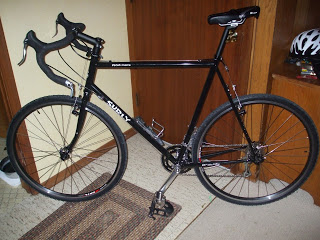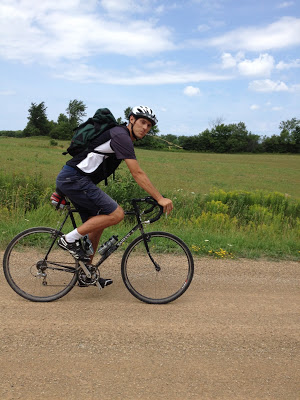After riding my 1980’s 66cm Norco Monterey for a season, it was time to ramp up my getting into biking to the next level. I needed a stiffer frame and a more versatile bike that could take me on country roads and trails in addition to paved roads. A cyclocross bike with two wheel sets best suits all of these riding styles. Also, I knew I was going to put 200mm cranks (for my 962mm inseam) on the bike, so needed a high bottom bracket, and cross bikes typically have larger bottom bracket drops (higher bottom brackets) than road, touring, or hybrid bikes. At 6′ 7″ and 220lb I can be hard on things. For this reason, and not wanting to spend too much money, I decided I needed a sturdy steel frame. Finally, my height meant I needed something with a long effective top tube length. After looking around at the various cyclocross bikes, I finally settled on the 700c 62cm Surly Cross Check (geometry and specs below). I had no idea at the time I had selected a very popular bike. The pic below is with the stock 175mm cranks.
| Seat Tube Length (Center-Top) |
620 |
| Top Tube Length (Center-Center) |
609.9 |
| Effective Top Tube Length (Center-Center) |
610 |
| Head Tube Angle |
72 |
| Seat Tube Angle |
72 |
| BB Drop | 66 |
| Chainstay Length |
425 |
| Wheelbase | 1054.7 |
| Standover Height |
866.2 |
| Head Tube Length |
180 |
| Fork Length | 400 |
| Fork Rake | 44 |
| Stack | 612.7 |
| Reach | 411 |
The widest stock drop bars you can get are 48cm. The 62cm Cross Check comes with 46cm, and this is good enough for me. I swapped the cranks for some aluminum square taper 200mm cranks with a compact 110BCD double spider from High Sierra Cycles. Putting them on a frame designed for 175mm cranks did some interesting things. Most obviously, it left me with poor pedal clearance and a greater risk of clipping a pedal while banking. The flip side of that is that I got to lower my seat an inch and thereby my center of gravity and my drafting in groups got more effective. Also, by lowering my seat, the handle bars were relatively higher (something a lot of taller riders would appreciate). In order to keep my patella over the 3 O’clock pedal position, the seat had to move forward. This effectively shortened the cock pit, so I put on a 140mm stem (up from 120mm) to compensate.
Despite all these needed adjustments, the bike ended up being a very good fit with nearly even weight on both wheels and the 200mm cranks gave me a big performance increase. The main problem is the low pedal clearance, particularly when I put the smaller road tires on. You certainly couldn’t do criteriums like this. However, being careful about it, I have only ever clipped my pedal twice when I was banking on rough ground and it wasn’t dangerous at all. However, I have read of others that were not so lucky!
Cons: I can’t stand bar end shifters, especially when riding in a tight group, it’s inconvenient and can be dangerous to be moving your hands to shift. I find cantilever breaks don’t provide enough breaking power. I’d prefer V-brakes or disc breaks for their power and cleaner cable routing. Of course, this would mean getting compatible drop bar brake levers and the Cross Check doesn’t have disc tabs. It is a heavy bike, though this is the cost of the sturdy steel frame I was looking for.
Pros: The bike is nice and stiff, very versatile, will last a long time, and was designed with an endearingly functional approach. Even if my needs change, I’m pretty sure I will be able to put this bike to good use for a long time to come.


There is a way to raise your bottom bracket on the Crosscheck, wider tires. The wider tires raise the whole bike higher. I managed to squeeze Schwalbe Big Apples (622-50) on it and think it sits an inch higher.
This site is awesome! I was searching the web because my sons Surly 62cm Cross Check was recently stolen and have been thrilled to find so much info for tall people. My son is 7-1 265lbs and it’s been a nightmare finding clothes, shoes, bikes… Thank you so much!
Glad you like it, thanks for the feedback!
My Surly Crosscheck is still standing after a nearly a decade and all kinds of modifications, including to an e-bike for tall people 🙂 It’s a great bike.
Hi there, I’m not quite your height (6’5″ barefoot measure) but I’m looking for a bike to take on a European tour where I’d prefer not to risk any damage/theft with my custom randonneur bike. Wondering about a 62cm Cross Check. I ride 180mm cranks so won’t have the pedal-strike problem that you do. My main concern: many people (mostly smaller riders) find the Cross Check a dead-feeling frame – which is to say, too stiff. (I’m in the camp that likes steel frames to be more flexible and lively, despite weighing 200 lb.)
How did the Cross Check feel to you in that department?
I’d say it’s not an overly stiff frame. I say this because when I went up to a Flite 747 by Lennard Zinn, I found the 747 to be significantly stiffer; I felt like I was able to deliver much more force to the ground with minimal frame flex. The Cross Check tubing walls are thick, but the overall diameter of the tubing is fairly small, so it ends up not being overly stiff, in my opinion. Whether that’s a good or bad thing, that’s up to you to decide.
Thank you, sir. I appreciate your taking the time to share this info.
I think that frame flex doesn’t mean energy that is lost, unless the frame actually heats up. Steel always springs back. Too noodly is difficult to ride and steer, though.
Jan Heine thinks (and has provided some data evidence) that flexible frames are actually faster, as long as using a frame material that springs back, because that energy eventually all ends up in the drivetrain anyway. He thinks that this gets returned to the drivetrain during otherwise-dead spots in the pedal stroke. This thinking comes from his experience of some bikes feeling faster and others feeling “dead” because they ‘resist’ the pedal strokes more. I’d love to see wider-scale testing of this, but it fits with the history of better steel frames being made from lighter tubing (which was also more flexible), and of how top pros often had time-trial bikes made of even flexier tubing (since they wouldn’t need to sprint on those bikes).
I see your point, steel performs elastically and so a bit of flex doesn’t result in lost energy, very interesting. So perhaps I just felt more confident getting out of the saddle and putting all of my weight and more into the stiffer 747. On the other side of the spectrum, I used to ride a 66cm Norco from the 80’s made with the exact same steel tubing as their tiny bikes. It had a huge triangle. Now that was flexible ride!
I’d never thought about it from that angle until I read Jan Heine’s stuff. His experience isn’t that more of his power makes it to the rear wheel on a more flexy bike, but rather that he is able to produce more power to begin with on a more-flexy bike.
Of course, he rides 56cm square frames. Most larger frames with traditional-diameter steel tubing will be somewhat flexy under someone 200+ lb.
I saw your post about the Norco. Too bad it had such a short top tube. I’ve got a 68cm Schwinn with 63.5 cm top tube, traditional steel diameters, in my office right now. Actually too big for me, though fun to ride.
That sounds like an interesting office you have 🙂
Make sure to write back here if you get that Surly and have any thoughts on it